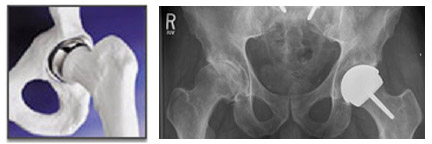|
|
| |
|
HIP
RESURFACING
Hip resurfacing is an alternative to total hip replacement and primarily
aimed toward young, active adults who, historically, have an increased
risk for failure of a conventional hip replacement. It allows patients
to have their arthritic, damaged hip bones reshape and
resurfaced, not removed. Unlike conventional hip replacement in hip
resurfacing only damaged cartilage is taken off from hip ball and socket.
This is replaced by same size of metal ball and metal socket. This
operation provides more durability and high activity level to all patients.
|
|
 |
|
Hip
Resurfacing Advantage
- Quantity
and quality of bone of the proximal femur preserved
- Femoral
head and neck re-shaped, not removed
- Minimal
acetabular bone is removed for insertion of the modern
generation resurfacing devices
- Minimal
risk of any leg length discrepancy
- Low
risk of dislocation
- Maximal
range of motion after surgery
- Relatively
easy and safe revision in the event of implant failure
- Very
likely return to high-level activities, such as tennis,
skiing, surfing, basketball, cycling and
skiing
- Low
rates of failure
|
|
| |
|
| MINIMALLY
INVASIVE HIP REPLACEMENT |
|
Minimally invasive hip replacement surgery was created to
allow surgeons to replace the hip through one or two smaller
incisions. When the surgical incisions are smaller, fewer
muscles and tendons are traumatized, which helps in a quicker
recovery for the patient. It also means less blood loss.
A single minimally invasive hip incision may measure only
3 to 6 inches, depending on the size of the patient and the
difficulty of the procedure. This incision is usually placed
over the outside of the thigh. Muscles and tendons are split
or detached to a lesser extent than in the traditional hip
replacement operation.
The operative technique involves the procedure performed
through a 6-8 cm curved incision over greater trochanter
as in standard posterolateral approach to the hip joint.
The procedure involves judicious use of special MI retractors
and angled acetabular reamers. The minimally invasive procedure
involves implantation of cementless acetabular and femoral
components and the focus is to make orthopaedic surgery
a less traumatic experience. The patients gain by reduced
blood
loss, less pain, faster return to full activity, shorter
hospital stay and reduced scar tissue.
Potential Advantages of MIS:
-
Less
blood loss
-
Less
trauma to the surrounding tissues
-
Shorter
hospital stays
-
Generally
earlier rehabilitation
However, MIS is not suitable for
everyone.
Successful candidates for this type of surgery are generally at a healthy
weight, in good health, younger than traditional
joint
replacement patients and must be motivated to work at their recovery.
|
|
| |
|
|